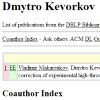| |
 
Daniel H. Huson and
David Bryant. Application of Phylogenetic Networks in Evolutionary Studies. In MBE, Vol. 23(2):254-267, 2006.
Keywords: abstract network, phylogenetic network, phylogeny, Program SplitsTree, software, survey.
Note: http://dx.doi.org/10.1093/molbev/msj030, software available from www.splitstree.org.
Toggle abstract
"The evolutionary history of a set of taxa is usually represented by a phylogenetic tree, and this model has greatly facilitated the discussion and testing of hypotheses. However, it is well known that more complex evolutionary scenarios are poorly described by such models. Further, even when evolution proceeds in a tree-like manner, analysis of the data may not be best served by using methods that enforce a tree structure but rather by a richer visualization of the data to evaluate its properties, at least as an essential first step. Thus, phylogenetic networks should be employed when reticulate events such as hybridization, horizontal gene transfer, recombination, or gene duplication and loss are believed to be involved, and, even in the absence of such events, phylogenetic networks have a useful role to play. This article reviews the terminology used for phylogenetic networks and covers both split networks and reticulate networks, how they are defined, and how they can be interpreted. Additionally, the article outlines the beginnings of a comprehensive statistical framework for applying split network methods. We show how split networks can represent confidence sets of trees and introduce a conservative statistical test for whether the conflicting signal in a network is treelike. Finally, this article describes a new program, SplitsTree4, an interactive and comprehensive tool for inferring different types of phylogenetic networks from sequences, distances, and trees. © The Author 2005. Published by Oxford University Press on behalf of the Society for Molecular Biology and Evolution. All rights reserved."
|
|
| |

François-Joseph Lapointe. How to account for reticulation events in phylogenetic analysis: A review of distance-based methods. In Journal of Classification, Vol. 17:175-184, 2000.
Keywords: abstract network, evaluation, from distances, phylogenetic network, Program Pyramids, Program SplitsTree, Program T REX, pyramid, reconstruction, reticulogram, split network, survey, weak hierarchy.
Note: http://dx.doi.org/10.1007/s003570000016.
|
|
| |
|
| |

David A. Morrison. Networks in phylogenetic analysis: new tools for population biology. In IJP, Vol. 35:567-582, 2005.
Keywords: median network, NeighborNet, phylogenetic network, phylogeny, population genetics, Program Network, Program Spectronet, Program SplitsTree, Program T REX, Program TCS, reconstruction, reticulogram, split decomposition, survey.
Note: http://hem.fyristorg.com/acacia/papers/networks.pdf.
|
|
| |
  
David Posada,
Keith A. Crandall and
Edward C. Holmes. Recombination in Evolutionary Genomics. In ARG, Vol. 36:75-97, 2002.
Keywords: phylogenetic network, phylogeny, recombination, recombination detection, survey.
Note: http://dx.doi.org/10.1146/annurev.genet.36.040202.111115.
Toggle abstract
"Recombination can be a dominant force in shaping genomes and associated phenotypes. To better understand the impact of recombination on genomic evolution, we need to be able to identify recombination in aligned sequences. We review bioinformatic approaches for detecting recombination and measuring recombination rates. We also examine the impact of recombination on the reconstruction of evolutionary histories and the estimation of population genetic parameters. Finally, we review the role of recombination in the evolutionary history of bacteria, viruses, and human mitochondria. We conclude by highlighting a number of areas for future development of tools to help quantify the role of recombination in genomic evolution."
|
|
| |
 
David Posada and
Keith A. Crandall. Intraspecific gene genealogies: trees grafting into networks. In TEE, Vol. 16(1):37-45, 2001.
Keywords: likelihood, median network, netting, parsimony, phylogenetic network, phylogeny, Program Arlequin, Program SplitsTree, Program T REX, Program TCS, pyramid, reticulogram, split decomposition, statistical parsimony, survey.
Note: http://darwin.uvigo.es/download/papers/09.networks01.pdf.
|
|
| |
 
Roderic D.M. Page and
Michael A. Charleston. Trees within trees: phylogeny and historical associations. In TEE, Vol. 13(9):356-359, 1998.
Keywords: duplication, explicit network, from rooted trees, from species tree, lateral gene transfer, phylogenetic network, phylogeny, reconstruction, survey.
Note: http://taxonomy.zoology.gla.ac.uk/rod/papers/tree.pdf.
|
|
| |

Mark A. Ragan. Trees and networks before and after Darwin. In Biology Direct, Vol. 4(43), 2009.
Keywords: abstract network, explicit network, phylogenetic network, phylogeny, survey, visualization.
Note: http://dx.doi.org/10.1186/1745-6150-4-43.
Toggle abstract
"It is well-known that Charles Darwin sketched abstract trees of relationship in his 1837 notebook, and depicted a tree in the Origin of Species (1859). Here I attempt to place Darwin's trees in historical context. By the mid-Eighteenth century the Great Chain of Being was increasingly seen to be an inadequate description of order in nature, and by about 1780 it had been largely abandoned without a satisfactory alternative having been agreed upon. In 1750 Donati described aquatic and terrestrial organisms as forming a network, and a few years later Buffon depicted a network of genealogical relationships among breeds of dogs. In 1764 Bonnet asked whether the Chain might actually branch at certain points, and in 1766 Pallas proposed that the gradations among organisms resemble a tree with a compound trunk, perhaps not unlike the tree of animal life later depicted by Eichwald. Other trees were presented by Augier in 1801 and by Lamarck in 1809 and 1815, the latter two assuming a transmutation of species over time. Elaborate networks of affinities among plants and among animals were depicted in the late Eighteenth and very early Nineteenth centuries. In the two decades immediately prior to 1837, so-called affinities and/or analogies among organisms were represented by diverse geometric figures. Series of plant and animal fossils in successive geological strata were represented as trees in a popular textbook from 1840, while in 1858 Bronn presented a system of animals, as evidenced by the fossil record, in a form of a tree. Darwin's 1859 tree and its subsequent elaborations by Haeckel came to be accepted in many but not all areas of biological sciences, while network diagrams were used in others. Beginning in the early 1960s trees were inferred from protein and nucleic acid sequences, but networks were re-introduced in the mid-1990s to represent lateral genetic transfer, increasingly regarded as a fundamental mode of evolution at least for bacteria and archaea. In historical context, then, the Network of Life preceded the Tree of Life and might again supersede it. Reviewers: This article was reviewed by Eric Bapteste, Patrick Forterre and Dan Graur. © 2009 Ragan; licensee BioMed Central Ltd."
|
|
| |

Robert G. Beiko. Gene sharing and genome evolution: networks in trees and trees in networks. In Biology and Philosophy, Vol. 25(4):659-673, 2010.
Keywords: abstract network, explicit network, from rooted trees, galled network, phylogenetic network, phylogeny, Program Dendroscope, Program SplitsTree, reconstruction, split network, survey.
Note: http://dx.doi.org/10.1007/s10539-010-9217-3.
Toggle abstract
"Frequent lateral genetic transfer undermines the existence of a unique "tree of life" that relates all organisms. Vertical inheritance is nonetheless of vital interest in the study of microbial evolution, and knowing the "tree of cells" can yield insights into ecological continuity, the rates of change of different cellular characters, and the evolutionary plasticity of genomes. Notwithstanding within-species recombination, the relationships most frequently recovered from genomic data at shallow to moderate taxonomic depths are likely to reflect cellular inheritance. At the same time, it is clear that several types of 'average signals' from whole genomes can be highly misleading, and the existence of a central tendency must not be taken as prima facie evidence of vertical descent. Phylogenetic networks offer an attractive solution, since they can be formulated in ways that mitigate the misleading aspects of hybrid evolutionary signals in genomes. But the connections in a network typically show genetic relatedness without distinguishing between vertical and lateral inheritance of genetic material. The solution may lie in a compromise between strict tree-thinking and network paradigms: build a phylogenetic network, but identify the set of connections in the network that are potentially due to vertical descent. Even if a single tree cannot be unambiguously identified, choosing a subnetwork of putative vertical connections can still lead to drastic reductions in the set of candidate vertical hypotheses. © 2010 Springer Science+Business Media B.V."
|
|
| |
 
Daniel H. Huson and
Celine Scornavacca. A survey of combinatorial methods for phylogenetic networks. In Genome Biology and Evolution, Vol. 3:23-35, 2011.
Keywords: phylogenetic network, survey.
Note: http://dx.doi.org/10.1093/gbe/evq077.
Toggle abstract
"The evolutionary history of a set of species is usually described by a rooted phylogenetic tree. Although it is generally undisputed that bifurcating speciation events and descent with modifications are major forces of evolution, there is a growing belief that reticulate events also have a role to play. Phylogenetic networks provide an alternative to phylogenetic trees and may be more suitable for data sets where evolution involves significant amounts of reticulate events, such as hybridization, horizontal gene transfer, or recombination. In this article, we give an introduction to the topic of phylogenetic networks, very briefly describing the fundamental concepts and summarizing some of the most important combinatorial methods that are available for their computation. © 2010 The Author(s)."
|
|
| |
   
Jean-Philippe Doyon,
Vincent Ranwez,
Vincent Daubin and
Vincent Berry. Models, algorithms and programs for phylogeny reconciliation. In Briefings in Bioinformatics, Vol. 12(5):392-400, 2011.
Keywords: explicit network, lateral gene transfer, phylogenetic network, phylogeny, reconstruction, survey.
Toggle abstract
"Gene sequences contain a goldmine of phylogenetic information. But unfortunately for taxonomists this information does not only tell the story of the species from which it was collected. Genes have their own complex histories which record speciation events, of course, but also many other events. Among them, gene duplications, transfers and losses are especially important to identify. These events are crucial to account for when reconstructing the history of species, and they play a fundamental role in the evolution of genomes, the diversification of organisms and the emergence of new cellular functions.We review reconciliations between gene and species trees, which are rigorous approaches for identifying duplications, transfers and losses that mark the evolution of a gene family. Existing reconciliation models and algorithms are reviewed and difficulties in modeling gene transfers are discussed. We also compare different reconciliation programs along with their advantages and disadvantages. © The Author 2011. Published by Oxford University Press."
|
|
| |
|
| |

Luay Nakhleh. Computational approaches to species phylogeny inference and gene tree reconciliation. In Trends in Ecology and Evolution, Vol. 28(12):719-728, 2013.
Keywords: from rooted trees, from species tree, phylogenetic network, phylogeny, reconstruction, survey.
Note: http://bioinfo.cs.rice.edu/sites/bioinfo.cs.rice.edu/files/TREE-Nakhleh13.pdf.
Toggle abstract
"An intricate relation exists between gene trees and species phylogenies, due to evolutionary processes that act on the genes within and across the branches of the species phylogeny. From an analytical perspective, gene trees serve as character states for inferring accurate species phylogenies, and species phylogenies serve as a backdrop against which gene trees are contrasted for elucidating evolutionary processes and parameters. In a 1997 paper, Maddison discussed this relation, reviewed the signatures left by three major evolutionary processes on the gene trees, and surveyed parsimony and likelihood criteria for utilizing these signatures to elucidate computationally this relation. Here, I review progress that has been made in developing computational methods for analyses under these two criteria, and survey remaining challenges. © 2013 Elsevier Ltd."
|
|
| |
|
| |
|
| |

Juan Wang. A Survey of Methods for Constructing Rooted Phylogenetic Networks. In PLoS ONE, Vol. 11(11):e0165834, 2016.
Keywords: evaluation, explicit network, from clusters, phylogenetic network, phylogeny, Program BIMLR, Program Dendroscope, Program LNetwork, reconstruction, survey.
Note: http://dx.doi.org/10.1371/journal.pone.0165834.
|
|
| |
|
| |
 
Juan Wang and
Maozu Guo. A review of metrics measuring dissimilarity for rooted phylogenetic networks. In Briefings in Bioinformatics, Vol. 20(6):1972-1980, 2019.
Keywords: distance between networks, explicit network, from network, mu distance, phylogenetic network, phylogeny, survey, tree sibling network, tree-child network.
|
|
| |
|
|
|
| |

Daniel H. Huson. Split networks and Reticulate Networks. In
Olivier Gascuel and
Mike Steel editors, Reconstructing Evolution, New Mathematical and Computational Advances, Pages 247-276, Oxford University Press, 2007.
Keywords: abstract network, consensus, from rooted trees, from sequences, from splits, from unrooted trees, galled tree, hybridization, phylogenetic network, phylogeny, Program Beagle, Program Spectronet, Program SplitsTree, Program SPNet, recombination, reconstruction, split network, survey.
Note: similar to http://www-ab.informatik.uni-tuebingen.de/research/phylonets/GCB2006.pdf.
|
|
| |
  
Vladimir Makarenkov,
Dmytro Kevorkov and
Pierre Legendre. Phylogenetic Network Construction Approaches. In Applied Mycology and Biotechnology, Vol. 6:61-97, 2006.
Keywords: from distances, hybridization, lateral gene transfer, median network, NeighborNet, netting, Program Arlequin, Program Network, Program Pyramids, Program Reticlad, Program SplitsTree, Program T REX, Program TCS, Program WeakHierarchies, pyramid, reticulogram, split, split decomposition, split network, survey, weak hierarchy.
Note: http://www.labunix.uqam.ca/~makarenv/makarenv/MKL_article.pdf.
|
|
| |
|
| |
 
Guillaume Bourque and
Louxin Zhang. Models and Methods in Comparative Genomics. In
Chau-Wen Tseng editor, Advances in Computers, Special Volume: Computational Biology, Vol. 68, Elsevier, 2006.
Keywords: from distances, from rooted trees, from sequences, galled tree, phylogenetic network, phylogeny, survey.
Note: http://www.math.nus.edu.sg/~matzlx/papers/CompGen_ZLX.pdf.
|
|
| |
|
| |
|
| |

Gabriel Valiente. Combinatorial Pattern Matching Algorithms in Computational Biology Using Perl and R. Pages 184-208, Taylor & Francis/CRC Press, 2009.
Keywords: counting, distance between networks, galled tree, generation, phylogenetic network, phylogeny, survey, time consistent network, tree sibling network, tree-child network.
Note: http://books.google.fr/books?id=F4YIIUWb7yMC.
|
|
| |

David A. Morrison. Phylogenetic networks in systematic biology (and elsewhere) In
R.M. Mohan editor, Research Advances in Systematic Biology, Global Research Network, Trivandrum, India, 2010.
Keywords: abstract network, explicit network, phylogenetic network, phylogeny, reconstruction, survey.
|
|
| |
|
| |
|
| |
|
| |
|
| |
|
| |
 
R. A. Leo Elworth,
Huw A. Ogilvie,
Jiafan Zhu and
Luay Nakhleh. Advances in Computational Methods for Phylogenetic Networks in the Presence of Hybridization. In
Tandy Warnow editor, Bioinformatics and Phylogenetics. Seminal Contributions of Bernard Moret, Vol. 29 of Computational Biology, Springer, 2019.
Keywords: explicit network, phylogenetic network, phylogeny, Program Dendroscope, Program PhyloNet, Program PhyloNetworks SNaQ, Program PIRN, Program SplitsTree, reconstruction, survey.
Note: https://bioinfocs.rice.edu/sites/g/files/bxs266/f/ElworthZhuOgilvieNakhleh.pdf
|
|
|
|
 - forked on GitHub.
- forked on GitHub.



















































